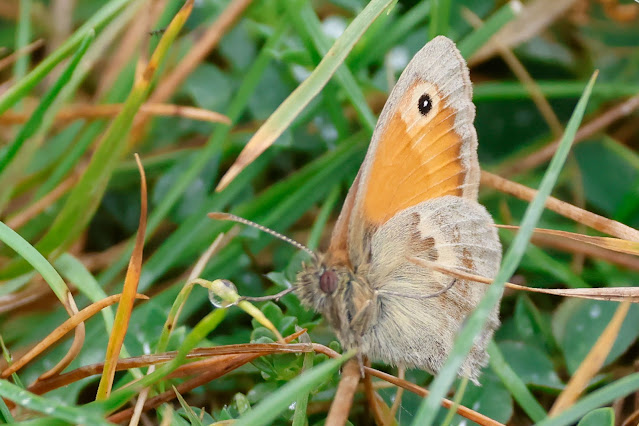I had to sit out the morning as heavy rain arrived just after 8:30 and seemed to stick around and not move away quickly. At lunchtime I decided to head out, it was still raining, but I was putting my faith in the local forecasts that said the sun would come out in the afternoon. As I arrived in the car park at Farlington Marshes, the rain had eased and by teh time I was sorted to move the sun was on its way out
I crossed the meadow through the bushes, the grass was wet but there were Meadow Brown flying. Then to my surprise I started to see Common Blue and not just one but several. They were not flying far but settling on the trefoil flowers and in amongst the grass.
The Common Blues were then joined by a few Small Heath.
A patch of Common Fleabane proved to be a butterfly magnet as the sun warmed things up. Meadow Brown and Gatekeeper buzzed around, but there were also many more Common Blues.
For the first time this year it felt like a butterfly summer with Common Blues flying everywhere.
I stopped along the stream to watch this Little Egret fishing.
At the information hut there was some activity along the hedge lined with bramble and reeds. First a Sedge Warble catching flies.
Then a Reed Warbler appeared.
Here both Reed and Sedge Warbler.
A better view of the Sedge Warbler.
Then a lemony green Willow Warbler.
There was two Sedge Warblers.
And at least three Reed Warblers.
Both the Sedge and Reed Warblers moved on, leaving the Willow Warbler to show well.
Close by a Meadow Pipit flew up into a dead bush.
I walked the path to the sea wall and passed clumps of more Common Fleabane and Tufted Vetch. On the Fleabane was a lovely Painted Lady.
While on the Tufted Vetch more Common Blues, this was now by far the most I have seen this year.
And to finish things off a Small Heath in amongst the grass.
Coming up on to the sea wall I scanned across to North Binness island. A usual spot for Osprey this time of year, but today the tree was occupied by a Peregrine. Terrible record shot in the heat haze.
There was little else until I reached the bottom of Point Field. The tide was up and on the island with the old wood were three largish waders. A closer look revealed them to be Whimbrel.
On reaching the Lake it was a shock to see the water levels so high and the reed bed looking completely dead. Whilst reeds like water they do not seem to be able to endure deep water. It would seem that there is an issue with the sluice and it is a question of money as to whether it will be fixed. I doubt we will be seeing many Bearded Tits here in the winter.
The stunning cloud formations above the Lake called out for some black and white images.
I walked around to the stream, hoping to find more butterflies, but ended up coming across a large wader roost on the stream. It consisted of mainly Black-tailed Godwits and Redshank but there was also a few Dunlin.
I stood back and tucked in beside a bush, but the roost was looking a little anxious.
This individual godwit flying around.
Things became a little more nervy.
Then they all went up in one huge flock and circled around the stream.
But settling back they still were not happy.
Then I saw the reason for the concern a Marsh Harrier, maybe a juvenile cruising over the back of the reed bed.
Despite all the commotion a single Greenshank appeared to be quite content.
The godwits settled back quickly once the harrier was out of sight, the Redshank took a little longer to return.
I made my way back to the car kicking up more Common Blues as I walked through the grass.













































No comments:
Post a Comment